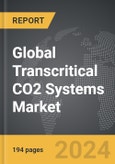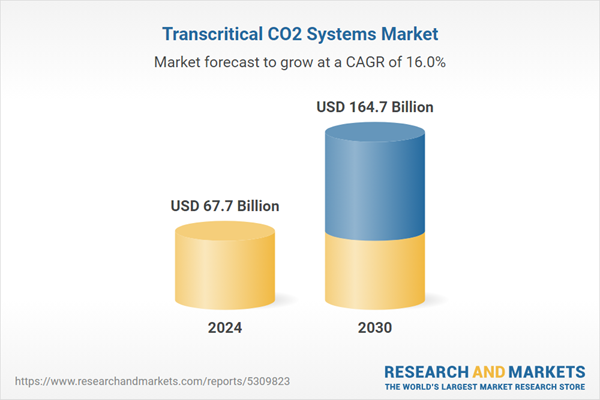The global market for Transcritical CO2 Systems was valued at US$67.7 Billion in 2024 and is projected to reach US$164.7 Billion by 2030, growing at a CAGR of 16.0% from 2024 to 2030. This comprehensive report provides an in-depth analysis of market trends, drivers, and forecasts, helping you make informed business decisions. The report includes the most recent global tariff developments and how they impact the Transcritical CO2 Systems market.
Segments: Function (Refrigeration, Heating, Air Conditioning); Application (Retail, Heat Pumps, Food Processing & Storage Facilities, Other Applications).
Geographic Regions/Countries: World; United States; Canada; Japan; China; Europe (France; Germany; Italy; United Kingdom; Spain; Russia; and Rest of Europe); Asia-Pacific (Australia; India; South Korea; and Rest of Asia-Pacific); Latin America (Argentina; Brazil; Mexico; and Rest of Latin America); Middle East (Iran; Israel; Saudi Arabia; United Arab Emirates; and Rest of Middle East); and Africa.
The analysts continuously track trade developments worldwide, drawing insights from leading global economists and over 200 industry and policy institutions, including think tanks, trade organizations, and national economic advisory bodies. This intelligence is integrated into forecasting models to provide timely, data-driven analysis of emerging risks and opportunities.
Global Transcritical CO2 Systems Market - Key Trends & Drivers Summarized
What are Transcritical CO2 Systems and Why are They Significant?
Transcritical CO2 Systems are advanced refrigeration systems that use carbon dioxide (CO2) as a refrigerant in a transcritical cycle, operating at pressures above the critical point of CO2. These systems are significant for their environmental benefits, as CO2 is a natural refrigerant with a very low global warming potential (GWP) compared to traditional synthetic refrigerants. Transcritical CO2 systems are used in various applications, including commercial refrigeration, industrial cooling, and heat pumps. Their importance lies in their ability to provide efficient and sustainable cooling solutions while minimizing the environmental impact of refrigeration practices, making them a key component in the transition to greener technologies.How Do Transcritical CO2 Systems Enhance Refrigeration Efficiency?
Transcritical CO2 Systems enhance refrigeration efficiency through their unique operating principles and advanced technology. These systems leverage the high thermodynamic properties of CO2, enabling efficient heat transfer and energy utilization. Innovations such as ejector technology, parallel compression, and advanced controls further improve the efficiency of transcritical CO2 systems, allowing them to perform well even in warmer climates. Additionally, the use of CO2 as a refrigerant eliminates the need for synthetic refrigerants, which are often less efficient and have higher environmental impacts. The overall system design, including heat exchangers and compressors, is optimized to maximize performance, resulting in lower energy consumption and operational costs. These factors contribute to the superior efficiency and sustainability of transcritical CO2 systems compared to conventional refrigeration technologies.Why is the Adoption of Transcritical CO2 Systems Growing?
The adoption of Transcritical CO2 Systems is growing due to several key factors. Increasing environmental regulations and the phase-down of synthetic refrigerants with high GWP are driving the demand for natural refrigerants like CO2. The focus on sustainability and reducing the environmental impact of refrigeration practices is encouraging the shift towards transcritical CO2 systems. Technological advancements and innovations in system design have made these systems more efficient and reliable, increasing their appeal to commercial and industrial users. Additionally, the rising awareness of the benefits of CO2 as a refrigerant, including its non-toxicity, non-flammability, and availability, is promoting its adoption. Government incentives and policies supporting the use of environmentally friendly technologies further propel the market for transcritical CO2 systems.What Factors are Driving the Growth of the Transcritical CO2 Systems Market?
The growth in the Transcritical CO2 Systems market is driven by several factors. Stringent environmental regulations and the global phase-down of high-GWP refrigerants are major drivers, as they necessitate the adoption of eco-friendly alternatives like CO2. Technological advancements in system components and design, such as the development of more efficient compressors and heat exchangers, enhance the performance and reliability of transcritical CO2 systems. The increasing focus on sustainability and energy efficiency in commercial and industrial sectors drives the demand for these systems. Rising awareness about the environmental and operational benefits of CO2 as a refrigerant also contributes to market growth. Government policies and incentives supporting the adoption of green technologies and the reduction of greenhouse gas emissions further propel the market. Additionally, the expanding application scope of transcritical CO2 systems, including their use in various industrial and commercial refrigeration and heating applications, underscores their growing importance and market potential.Report Scope
The report analyzes the Transcritical CO2 Systems market, presented in terms of units. The analysis covers the key segments and geographic regions outlined below.Segments: Function (Refrigeration, Heating, Air Conditioning); Application (Retail, Heat Pumps, Food Processing & Storage Facilities, Other Applications).
Geographic Regions/Countries: World; United States; Canada; Japan; China; Europe (France; Germany; Italy; United Kingdom; Spain; Russia; and Rest of Europe); Asia-Pacific (Australia; India; South Korea; and Rest of Asia-Pacific); Latin America (Argentina; Brazil; Mexico; and Rest of Latin America); Middle East (Iran; Israel; Saudi Arabia; United Arab Emirates; and Rest of Middle East); and Africa.
Key Insights:
- Market Growth: Understand the significant growth trajectory of the Refrigeration segment, which is expected to reach US$105.9 Billion by 2030 with a CAGR of a 15.4%. The Heating segment is also set to grow at 17.7% CAGR over the analysis period.
- Regional Analysis: Gain insights into the U.S. market, valued at $17.7 Billion in 2024, and China, forecasted to grow at an impressive 20.6% CAGR to reach $39.6 Billion by 2030. Discover growth trends in other key regions, including Japan, Canada, Germany, and the Asia-Pacific.
Why You Should Buy This Report:
- Detailed Market Analysis: Access a thorough analysis of the Global Transcritical CO2 Systems Market, covering all major geographic regions and market segments.
- Competitive Insights: Get an overview of the competitive landscape, including the market presence of major players across different geographies.
- Future Trends and Drivers: Understand the key trends and drivers shaping the future of the Global Transcritical CO2 Systems Market.
- Actionable Insights: Benefit from actionable insights that can help you identify new revenue opportunities and make strategic business decisions.
Key Questions Answered:
- How is the Global Transcritical CO2 Systems Market expected to evolve by 2030?
- What are the main drivers and restraints affecting the market?
- Which market segments will grow the most over the forecast period?
- How will market shares for different regions and segments change by 2030?
- Who are the leading players in the market, and what are their prospects?
Report Features:
- Comprehensive Market Data: Independent analysis of annual sales and market forecasts in US$ Million from 2024 to 2030.
- In-Depth Regional Analysis: Detailed insights into key markets, including the U.S., China, Japan, Canada, Europe, Asia-Pacific, Latin America, Middle East, and Africa.
- Company Profiles: Coverage of players such as Antares Pharma, Inc., Bayer AG, Durect Corporation, Iontera, Inc., Janssen Pharmaceuticals, Inc. and more.
- Complimentary Updates: Receive free report updates for one year to keep you informed of the latest market developments.
Some of the 41 companies featured in this Transcritical CO2 Systems market report include:
- Antares Pharma, Inc.
- Bayer AG
- Durect Corporation
- Iontera, Inc.
- Janssen Pharmaceuticals, Inc.
- Nitto Denko Corporation
- Novartis AG
- Pantec Biosolutions AG
- Tesa Labtec GmbH
- Teva Pharmaceutical Industries Ltd.
Tariff Impact Analysis: Key Insights for 2025
Global tariff negotiations across 180+ countries are reshaping supply chains, costs, and competitiveness. This report reflects the latest developments as of April 2025 and incorporates forward-looking insights into the market outlook.The analysts continuously track trade developments worldwide, drawing insights from leading global economists and over 200 industry and policy institutions, including think tanks, trade organizations, and national economic advisory bodies. This intelligence is integrated into forecasting models to provide timely, data-driven analysis of emerging risks and opportunities.
What’s Included in This Edition:
- Tariff-adjusted market forecasts by region and segment
- Analysis of cost and supply chain implications by sourcing and trade exposure
- Strategic insights into geographic shifts
Buyers receive a free July 2025 update with:
- Finalized tariff impacts and new trade agreement effects
- Updated projections reflecting global sourcing and cost shifts
- Expanded country-specific coverage across the industry
Table of Contents
I. METHODOLOGYII. EXECUTIVE SUMMARY2. FOCUS ON SELECT PLAYERSIII. MARKET ANALYSISSOUTH KOREAREST OF ASIA-PACIFICARGENTINABRAZILMEXICOREST OF LATIN AMERICAIRANISRAELSAUDI ARABIAUNITED ARAB EMIRATESREST OF MIDDLE EASTIV. COMPETITION
1. MARKET OVERVIEW
3. MARKET TRENDS & DRIVERS
4. GLOBAL MARKET PERSPECTIVE
UNITED STATES
CANADA
JAPAN
CHINA
EUROPE
FRANCE
GERMANY
ITALY
UNITED KINGDOM
SPAIN
RUSSIA
REST OF EUROPE
ASIA-PACIFIC
AUSTRALIA
INDIA
LATIN AMERICA
MIDDLE EAST
AFRICA
Companies Mentioned (Partial List)
A selection of companies mentioned in this report includes, but is not limited to:
- Antares Pharma, Inc.
- Bayer AG
- Durect Corporation
- Iontera, Inc.
- Janssen Pharmaceuticals, Inc.
- Nitto Denko Corporation
- Novartis AG
- Pantec Biosolutions AG
- Tesa Labtec GmbH
- Teva Pharmaceutical Industries Ltd.
Table Information
| Report Attribute | Details |
|---|---|
| No. of Pages | 194 |
| Published | April 2025 |
| Forecast Period | 2024 - 2030 |
| Estimated Market Value ( USD | $ 67.7 Billion |
| Forecasted Market Value ( USD | $ 164.7 Billion |
| Compound Annual Growth Rate | 16.0% |
| Regions Covered | Global |









